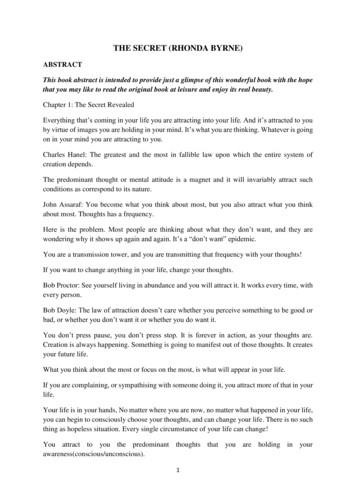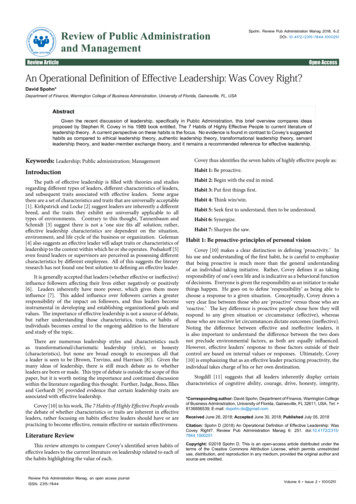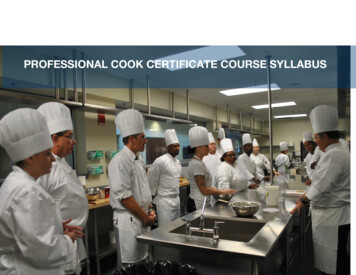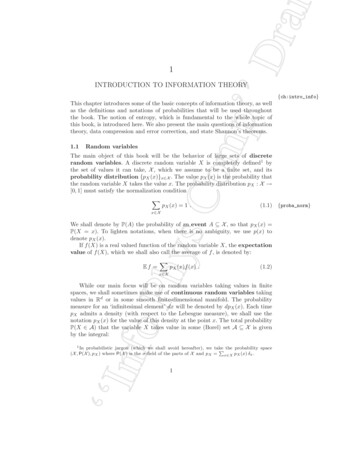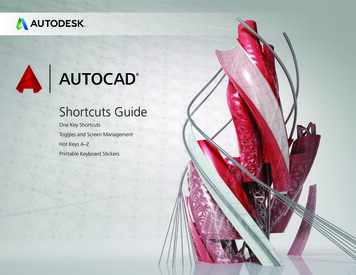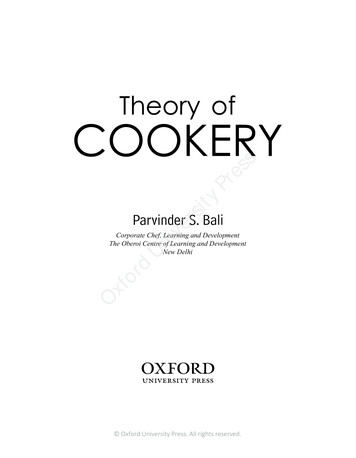
Transcription
PresssityiverParvinder S. BaliOxfordUnCorporate Chef, Learning and DevelopmentThe Oberoi Centre of Learning and DevelopmentNew Delhi Oxford University Press. All rights reserved.
Oxford University Press is a department of the University of Oxford.It furthers the University’s objective of excellence in research, scholarship,and education by publishing worldwide. Oxford is a registered trade mark ofOxford University Press in the UK and in certain other countries.Published in India byOxford University PressYMCA Library Building, 1 Jai Singh Road, New Delhi 110001, India Oxford University Press 2017The moral rights of the author/s have been asserted.First published in 2017sityPressAll rights reserved. No part of this publication may be reproduced, stored ina retrieval system, or transmitted, in any form or by any means, without theprior permission in writing of Oxford University Press, or as expressly permittedby law, by licence, or under terms agreed with the appropriate reprographicsrights organization. Enquiries concerning reproduction outside the scope of theabove should be sent to the Rights Department, Oxford University Press, at theaddress above.You must not circulate this work in any other formand you must impose this same condition on any acquirer.iverISBN-13: 978-0-19-947444-8ISBN-10: 0-19-947444-3UnTypeset in GaramondbyVersatile PreMediaPremedia ServicesServices PvtPvt Ltd.Ltd, PunePuneby VersatilePrinted in India by Magic International (P) Ltd, Greater NoidadCover image: Mixform design / ShutterstockOxforThird-party website addresses mentioned in this book are providedby Oxford University Press in good faith and for information only.Oxford University Press disclaims any responsibility for the material contained therein. Oxford University Press. All rights reserved.
PrefaceorABOUT THE BOOKdUniversityPressIs cooking an art or a science? Cooking is a domain that blends both art and science. The science ofidentifying and collecting basic ingredients, measuring quantities, and timing the whole process is thefirst step towards perfect cooking. The way of presenting a dish, pairing food, and understanding aromais an art that is learnt by experience. Again, the process of transforming cereals and pulses, vegetables,and meat into delectable delights is an art perfected by science.Globalization has changed the mind-set of many youngsters in India who wish to pursue a careerin hospitality. With many international chains coming to India, more and more job opportunities areseen to have been created in the kitchen because of shortage of skilled culinary professionals. In fact,with this surge of good hotels in the country, it has become fundamental for students to develop a keeninterest in understanding the subject; hence making it a much sought-after course.Today a career in hospitality is chosen by many students also due to awareness created by media andpromotional activities around food. Travel and leisure industries are offering lucrative deals and morepeople are travelling in search of unexplored destinations. With new destinations, new flavours andnew ingredients are being popularised all across the world. Food tourism is another concept that manycountries are promoting to boost their tourism.OxfThe book is intended for students of diploma and food craft courses in hotel management, catering tothe syllabus of National Council for Hotel Management and Catering Technology. It has been designedto give an introduction to cookery, organizational structure and layout of a professional kitchen, basicmenu planning, aims and methods of cooking food as well as responsibilities of various chefs. It willhelp students to gain technical knowledge and skills of cooking as well as familiarize themselves withthe day-to-day working atmosphere of the department.It has been developed keeping in mind the changing trends in modern kitchen. As there are myriaddifferences in the commodities and technology used across the world, it is important that one should beaware of the dynamics of kitchen operations. The book also brings in my 24 years of experience with OberoiHotels and Resorts. This professional knowledge percolates down through chapters in the form of ‘cheftips’, which have been handed and circulated by chefs down the generations.PEDAGOGICAL FEATURES Discusses roles of various commodities used in cooking along with different methods of cooking,such as sautéing, steaming, braising, microwave cooking, and more Includes detailed discussions on methods of cooking and various features of a professional kitchen Oxford University Press. All rights reserved.
viPreface Begins every chapter with learning objectives which give an introduction to the various topicsdiscussed in the chapter Concludes chapters with a summary to help students gather all that they have studied in the chapter Provides important points (chef ’s tips) interspersed in the text to avoid accidents in the kitchen Explains practical aspects of cookery with photographs, tables, and figures Includes assessment tools such as objective type questions, review questions, and project assignmentsSTRUCTURE AND COVERAGEThe book is divided into nine chapters.Chapter 1, Introduction to Cookery, provides a discussion on skills, attitudes, and behaviour required towork in a professional kitchen. Uniforms and safety procedures in handling equipments are also coveredalong with origin of modern cookery and culinary terms.PressChapter 2, Organizational Structure and Layout of Kitchen, gives an overview of the modern staffing invarious category hotels, responsibilities and duties of chefs, and layout of a professional kitchen.sityChapter 3, Basic Menu Planning, discusses functions and types of menu. It also explains menuengineering grid, menu balancing, and pairing of food and wine.erChapter 4, Aims and Objects of Cooking Food, explains objectives of cooking, and ways of controllingchanges in texture and techniques used in pre-preparation. It also discusses role of fats, souring agents,colouring agents, thickening agents, and aromatic agents used in cooking.UnivChapter 5, Use of Vegetable and Fruits in Cookery, elaborates on classification of vegetables and fruitsalong with their usage in cooking. Controlling changes in texture, flavour and nutrient loss of thevegetable and fruit is also covered in it.ordChapter 6, Stocks, Sauces, and Gravies, discusses classification of stocks, components of a sauce, andpreparation of gravies. Mother and contemporary sauces, their derivatives, and modern trends ofmaking sauce has also been elaborated upon.OxfChapter 7, Salads and Soups, elaborates on the composition and types of a salad, as also emerging trendsin salad making and salient features of preparing good salads. Classification, preparation, and trends ofpresenting soups have also been covered.Chapter 8, Meat, Fish, and Egg Cookery, discusses properties, and types of meat, fish, and egg. Processingof a whole animal, common cooking methods used for seafood and cooking preparation for eggs aresome of the highlights of the chapter.Chapter 9, Methods of Cooking Food, explains different ways of cooking such as blanching, poaching,stewing, braising, poeing, roasting, grilling, sautéing, frying, baking, and many more. Microwavecooking is also discussed.ACKNOWLEDGEMENTSI would like to mention certain people and organizations who have either directly or indirectlycontributed towards this book. First and foremost I would like to mention our Chairman Mr PrithviRaj Singh Oberoi, our Managing Director and CEO, Mr Vikram Oberoi, under whose able guidance Ihave been able to collect all the knowledge pertaining to this book. I would like to thank Oberoi Centre Oxford University Press. All rights reserved.
PrefaceviiOxfordUniversityPressof Learning and Development for letting me use the resources for research. I would like special mentionof all my colleagues and friends who have lent their encouragement and support in this venture of mine.I would like to thank the whole Oberoi Group for their support.My acknowledgments would be incomplete if I did not acknowledge the academicians and thereviewers, who reviewed the book and gave corrective feedback that helped me frame the contents of thebook. I would like to thank the editors and the team at Oxford University Press India for their constantfollow-ups and all the support that motivated me to accomplish this project.I would also like to thank all my near and dear ones and professionals in the industry who have insome ways influenced the development of this book.Last but not the least, I would like to appreciate the support of my wife Shalini and my children,Ojas and Amora, who have shown immense patience whilst I compiled my fourth book.Any suggestions for the improvement of the book in terms of content and presentation are welcome.Suggestions may be sent to the publishers or me at Parvinder.Bali@oberoigroup.com. I will be veryhappy to receive any feedback.Parvinder S. Bali Oxford University Press. All rights reserved.
Features ofChef’s tipImportant pointsthat should bekept in mindappear as tipsthroughout thetext for quickrecapitulation.ordUnACTIVITYPrepare vegetable stew observe and note the following:(1) time taken; (2) nutrients lost; (3) heat transference; (4)category; (5) temperature range; and (6) accompanied with?OxfActivitiesActivities havebeen interspersedin the chaptersto aid students inunderstanding thepractical side of thesubject.iversityPressCHEF’S TIP If oil falls on the floor and there is no time to clean,immediately sprinkle salt on it. The friction will prevent slips. If there are any spillages such as oil, water, or food substance,it should be cleaned up immediately. Signage should be put on wet floor while cleaning ofkitchens. Proper storage should be available to keep floors clear. Ensuring that non slippery and covered footwear is worn bykitchen and the ancillary staff working in the kitchen.ExercisesA series of objectivetype questions aswell as to-do activityhighlight the majortopics covered inthe chapter. Thequestions enhancelearning and canbe used for reviewand classroomdiscussion. Oxford University Press. All rights reserved.
the BookTable8.2Bull/CowSteerHeiferVealCastrated Cow which has notMale is called bull.Female is called cow male bull. calved yet.after calving.12RumpLoin (6, 7, 8)Rib (4, 5)PressChuck (1, 2, 3)85437616151314171191210Plate (13,14)erClod (15,16)Fore shankYearling bull/CowYoung cattle from Bull or cow under 120–3 months.months of age.sityFiguresand TablesAllchapterscontainfigures andtables toillustratethe topicsdiscussedin thechapters.Classification of beefFlank (11,12)Hind shankOxfordUnivFig. 8.2 Wholesale cuts of beefPhotographsPhotographs have beenadded in the chapters tohelp readers understandconcepts better.Fig. 2.12Show kitchen Oxford University Press. All rights reserved.
Brief ContentsIntroduction to Cookery2Organizational Structure and Layout of Kitchen3Basic Menu Planning4Aims and Objectives of Cooking Food5Use of Vegetables and Fruits in Cookery6Stocks, Sauces, and Gravies7Soups and Salads8Meat, Fish, and Egg Cookery9Methods of CookingOxfordUniver1sityPressPrefacevFeatures of the BookviiiDetailed ContentsxiAppendix206Index220About the Author231 Oxford University Press. All rights reserved.119405086106137152182
Detailed Contents1orerdUnivIntroduction1Types of Kitchens1Receiving area2Food stores2Commissary kitchen3Main kitchen3Scope of Becoming a Chef 4Product5Process5Profit5People5Attitude and Behaviour in the KitchenDistraction7Haste7Failure to Observe Rules andRegulations7Personal Hygiene and Food Safety7Personal Hygiene and Its Importance inthe Kitchen8Uniform and Protective Clothing9Chef ’s Jacket10Chef ’s Trousers10Chef ’s Hat10Scarf/Neckerchief10Apron10Kitchen Towel/Duster11Shoes11Identification of Knives and How toSharpen Them11Safety Procedures in HandlingEquipment: Ergonomics12Hazardous Chemicals and OtherSubstances14Sprains and Strains in the KitchenTemperature16Burns and Scalds16Origin of Modern Cookery16sityIntroduction to CookeryOxf1viiiPressPrefacevFeatures of the BookBrief Contentsx72Organizational Structureand Layout of KitchenIntroduction19Kitchen brigade20Organizational structure of the kitchenModern Staffing in Various CategoryHotels23Duties and Responsibilities of VariousChefs26Layout of Kitchen Department30General Kitchen Layout31Commissary34Main Kitchen34 Oxford University Press. All rights reserved.141920
Detailed Contents3536Basic Menu Planning405ord4 Aims and Objectives ofCooking FoodUnivIntroduction40Menu41Functions of the Menu41Types of Menu41Menu Used as Control Tool43Menu Specifications43Menu Composition43Menu Engineering43Menu Engineering Grid44Stars44Plow Horse45Puzzle45Dogs45Menu Engineering Worksheet45Menu Balancing46Selecting Dishes and Courses47Wine and Food Pairing48OxfIntroduction50Why do we Need to Cook Food? 51Various Textures and Consistencies52Controlling the Changes in Texture andTechniques Used in Pre-Preparation55Commodities Used for Cooking56Flour57Raising Agents 58Fats and Oils59Vegetable Oils62Milk and dairy products63Sweeteners70Souring Agents used in Cooking70Colouring Agents Used in IndianCooking76Use of Vegetables and Fruitsin Cookery86Introduction86Vegetables86Pigment and Colour Changes89Effects of Heat on Vegetables91Carbohydrates91Vegetable Fibres91Minerals, Vitamins, Pigments, andFlavour Components 91Proteins91Controlling the Changes in Texture92Fibre92Starch92Doneness92Controlling Changes in Flavour92Controlling the Colour of theVegetables93Controlling Nutrient Loss93Cuts of Vegetables94Some indian cuts of vegetables96Fruits99Why Eat Fruits?99Classification of fruits99On Basis of Texture and Flavour100On Basis of Appearance and FleshContent100Fruits in Cooking103Press3Thickening Agents Used in Cooking79Tenderizing Agents Used in IndianCooking80Flavouring and Aromatic Agents Used inIndian Cooking81Spicing Agents Used in Indian Cooking81sityButchery3535Garde MangerBakery and ConfectioneryWestern Banquet KitchenShow Kitchen36erxii506 Stocks, Sauces, and GraviesIntroduction106Stocks107Classification of stocksWhite Stock107Brown Stock108 Oxford University Press. All rights reserved.107106
Detailed ContentsIndian Gravies129Gravies and Curries129Regional Gravies131Indian Restaurant Food vs HomemadeIndian Food133Preparation of Gravy134Soups and SaladssityivUndorOxf137Soups137Classification of eam139Bisque139Chowder140Cold Soups140International Soups140Making of a Good Soup142Modern Trends of Presenting Soups143Salads 143Base144Body144Dressing144Garnish144Types of Salad144Simple Salads145Compound Salads145Tossed Salads 145Various Types of Lettuce Used inSalads145Salad Dressing146Oil-based Dressings147Fresh Cream-based Dressings148Mayonnaise-based Dressings148Natural Yoghurt Dressings148Emerging Trends in Salad Making148Buffet Layouts and Presentation148Healthy Approach149Deconstructed Approach149New Approach to Classical Salads149Press7er109Stocks and Their UsesPreparation of Stocks110Sauces117Uses of Sauces117Flavour117Moisture117Visual Appeal118Texture119Nutritional Factor119Thickening Agents119Roux119Slurry120Beurre Manié120Liaison120Blood120Butter120Vegetable or Fruit Purees120Mother Sauces120Béchamel (White Sauce)121Velouté 121Espagnole (Brown Sauce)121Tomato Sauce121Hollandaise Sauce (Dutch Sauce)121Mayonnaise Sauce122Preparation of Mother Sauces122Derivatives of Mother daise126Mayonnaise126Proprietary Sauces126Soya Sauce126Worcestershire Sauce127HP Sauce127Barbecue Sauce127Ketchup127Tabasco Sauce127Chilli Sauce127Contemporary Sauces127Making of a Good Sauce128Modern Trends of Making Sauces129xiii Oxford University Press. All rights reserved.
xivDetailed ContentsFlavour Profiles149149Live Salad StationSalient Features of Preparing GoodSalads 150ordPresssityerUnMeat 152Physical and Chemical Characteristicsof Meats 153Physical Characteristics153Chemical Characteristics153Selecting and Grading Meat153Quality153Yield Grading154Processing of a Whole Animal155Examination155Resting of Animals155Cleaning and Sanitizing155Stunning 155Slaughter155Bleeding155Meat Ageing155Classification of Meats156Categories of Meat156Lamb 156Beef158Pork160Poultry162Game163Large Game164Small Game 164Yield Tests164Fish and Shellfish165Classification of Fish165Habitat165Physical Shape166Flesh Type166Classification of Shellfish166Crustaceans166Molluscs167Cuts of Fish167Preliminary Cleaning 167Filleting168Some Famous Species of Fish168Anchovy168152ivMeat, Fish, and Egg CookeryOxf8Salmon 168Some Classical Preparations of Fish 169Rollmop Selection and Storage of Seafood170Selection170Storage170Common Cooking Methods Used d and Hot Poaching171Olive Oil Poaching171Steaming171Roasting and Slow Roasting 172Smoking or Curing172Cooking Shellfish172Eggs172Structure of an Egg172Shell172Yolk 173Vitelline173Chalazae173Shell Membranes173Air Cell173Thin Albumen 173Thick Albumen 174Selection of Eggs174Storage of Eggs175Uses of Eggs175Coagulation 175Leavening176Emulsification 176Cooking of Eggs for Breakfast176Boiled176Fried Eggs177Shirred Eggs179Omelettes179Seasoning a Fry Pan 179Egg Preparation180 Oxford University Press. All rights reserved.
Detailed Contents9Methods of Sautéing196Frying198Baking199Microwave Cooking201Healthy Methods of Cooking, Especiallyfor Heart Diabetic re Range184Blanching and Its Uses185Poaching185Boiling186Steaming dex220About the Author Oxford University Press. All rights reserved.xv
5Use of Vegetables andFruits in CookeryAfter reading this chapter, you will be able toPressLEARNING OBJECTIVESorINTRODUCTIONdUniversityidentify various types of vegetables used in the kitchenknow the way a vegetable is processedfigure out the selection and storage criteria of vegetablesunderstand the pigments in the vegetables and the effect of heat on themlist the cuts of vegetables and their uses in cookeryidentify various types of fruits used in the kitchens and classify themknow the way a fruit is processedfigure out the selection and storage criteria of a fruit commoditylist out the advantages of using fruits in cookingOxfIn the previous chapters, we understood the basic work operation of the kitchen in terms of layouts,equipment, and fuels, and various kinds of menus. Now let us begin our journey to being professionalchefs by understanding about various commodities used in the kitchen.VEGETABLESAny part of a herbaceous plant that can be eaten, either raw or cooked, is termed as vegetable. Vegetablescontain more of starch than sugar unlike fruits and hence, they are used extensively in savoury dishes.Vegetables can be used in a variety of forms such as frozen, canned, cooked, mashed, dried, dehydrated,or fresh. However, only selected parts of some plants are eaten such as flowers, flower buds (globeartichoke), leaves (lettuce), leaf buds (brussels sprouts), shoots (asparagus), shoot buds (cabbage), stems(rhubarb), flower stems (cauliflower), seed pods (green beans), and immature seeds (broad bean); seeFig. 5.1 for figures of some vegetables.Vegetables are eaten in a variety of ways—as main courses or as snacks. Different vegetables havedifferent types of nutrients in them including water-soluble vitamins such as vitamin B and C, andfat-soluble vitamins such as A, D, E, and K, and also contain minerals and carbohydrates. Since each Oxford University Press. All rights reserved.
Use of Vegetables and Fruits in Cookery(ii)(iv)Bell pepper(vii)Cauliflower(v)AubergineBibbs ersity(i)(ix)Cherry tomatoesOxford(viii) Celery(x)Coriander leaves(xiii)Fennel bulb(xi)Cos lettuce(xiv) French beansFig. 5.1 Vegetables (Cont.)(xii)Dragon fruit(xv)Green beans(Source: Thinkstock/OUP Picture Bank) Oxford University Press. All rights reserved.87
Theory of Cookery(xvii)Iceberg (xxiv)Red sangria xvi)Rocket lettuce(xxix)TurnipFig. 5.1 Vegetables(Source: Thinkstock/OUP Picture Bank) Oxford University Press. All rights reserved.(xxvii)(xxx)ThymeZuchinni
Use of Vegetables and Fruits in CookeryTable 5.1Category89Classification of vegetablesDescriptionExamplesBrassica or the cabbage family consists of vegetables used for theirhead, leaves, or flowers and are mostly used in broths and braiseddishes to accompany meats.Cabbage, cauliflower,brussels sprouts, and bokchoyFruitvegetablesThese are the fruits of flowering plants. They also contain seeds.Tomato, avocado, brinjal,and pepperGourdsandsquashesThe gourds are classified into summer squashes and winter gourds.There are over 750 varieties of gourds grown around the world. Thelong trailing vines of a complex root system bears this vegetable,adorned by large leaves and attractive flowers.Bottle gourd, butternutsquash, and ridged gourdGreensThis refers to vegetables that are leafy and eaten cooked, with theexception of lettuce. Most of the greens are mildly spiced and slightlystrong in flavour.Spinach, watercress, andradicchioFungusAlthough not a real vegetable, fungus is a plant that has no seed, stem,or flower and usually reproduces from the spores. It is commonlyknown as mushroom. One must be careful in selecting a mushroom.Button mushroom, shitake,portobello, and porciniRoots andtubersThough roots and tubers are the same, however, scientifically speaking,tubers are fat underground stems whereas roots are the single bulbs,which extend into the ground that supplies the plant with nutrients.The tubers would be more starchy.Root vegetables—carrots,radish, and onions.Tubers—potatoes, Jerusalemartichoke, and colocasiaPods andseedsIn some vegetables, only seeds are eaten such as in case of peas, corn,and pulses whereas, in others, the plant is eaten as whole such asokra, snap peas, and French beans. They contain the highest source ofproteins and carbohydrates.Green peas, okra, snap peas,and pulsesStemsAlso known as stalk vegetables, they have the highest percentage ofcellulose fibre and are usually eaten when they are young and tender.Celery and rhubarbBabyvegetablesThis is a very modern classification of vegetables that includevegetables created with hybrid varieties or are picked up beforematurity.Tiny turnips, babycauliflower, baby carrots,and baby squashesOxfordUniversityPressBrassicacategory of vegetable responds to a particular method of cooking, it is important for us to know howthey are categorized. Broadly speaking, vegetables are put into the categories discussed in Table 5.1.PIGMENT AND COLOUR CHANGESIt is important for chefs to know the various kinds of pigments present in food and how they react toheat and various acidic and alkaline medium, as this would largely impact the style of cooking them.Pigment is the colouring matter within the cells and tissues of the plant. The various types of pigmentsare affected differently by heat, acid, alkali, and other elements involved in cooking. To maintain asACTIVITYName common acid and alkali ingredients used in our day-to-day cooking. Which dishesdo we use them in? Oxford University Press. All rights reserved.
90Theory of Cookerymuch colour as possible in cooked vegetables, one needs to know about these pigments. Each vegetablehas trace amount of acid present in it and we shall see how this acid could be used favourably.Table 5.2 summarizes the effect of various factors on the colour of plant pigments.Table 5.2Solubilityin WaterCarotenoidsYellow andorange; someare red or pinkAnthocyanins Red, purple,and blueBetalainsPurplish red;some are yellowAnthoxanthin White orcolourlessEffect of MetalOlive greenChanges to olivegreen in ironNoneSlightlysolubleSlightlysolubleChanges toolive greenLess intensecolourIntensifiesgreenLittle effectVerysolubleVerysolubleVerysolubleRedPurple or blueLittle effectLittle olour may beless intenseLittle effectYellowViolet or bluewith tin or ironNoneDark with iron,bright yellowwith aluminiumAdding acid toOvercookingyellowed whitewill also turnthese vegetables vegetables willnot make themyellow or grey.This reaction is retain theiroriginal whitenot reversible.colour.ordUnivWhiteEffect ofProlonged IonsCHEF’S TIPTo retain the original white colour of the flavones pigment, one must cover the whitevegetable while cooking. This allows the acids released from the vegetable during cookingto blend with the vegetable. Use short cooking time and add a small amount of lemonjuice, cream of tartar, or vinegar to the cooking liquid to create a slightly acidic medium.OxfFlavonesEffect of AlkaliHeatingPressGreenEffect ofAcidsityChlorophyllColourerName of thePigmentEffects on the pigments of vegetablesCHEF’S TIPTo retain as much of the natural green colour as possible do as follows: Cook vegetables uncovered to allow the volatile acids to escape. Cook them quickly until just al dente. Extended exposure to heat will destroy the colour and leach out nutrients. After boiling, plunge the vegetables into cold water to arrest cooking. This helps tobrighten the colours and is known as shocking or refreshing. Cook the vegetables in small batches; this reduces the cooking and holding time. Do not hold for long periods of time. Steam the green vegetables whenever possible. This shortens the cooking time, allowsfar less acid build up, and retains more colours. Oxford University Press. All rights reserved.
Use of Vegetables and Fruits in Cookery91CHEF’S TIPIf beets are not peeled and one or two inches of the stems are left intact, they may becooked in boiling water, without loss of pigment and colour. They can be peeled aftercooking.EFFECTS OF HEAT ON VEGETABLESPressCooking is the application of heat to food in order to make it safer to eat, digestible, and more palatable.Heat breaks down the cellulose and the starches present, changes and blends flavours within the food,and also destroys bacteria in order to make food more digestible for humans.Vegetables and other foods are composed of proteins, fats, carbohydrates, water, and also smallamounts of minerals, vitamins, pigments (colouring agents), and flavour elements. Let us now look athow these are affected because of heat.CarbohydratesersityBoth sugar and starch are carbohydrates and are present in many forms in vegetables, fruits, grains,beans, and nuts.Heating food rich in carbohydrates leads to caramelization and gelatinization. Where caramelizationrefers to browning of sautéed vegetables, gelatinization refers to when starch absorbs water and swells.ivVegetable FibresordUnFibres are a group of complex substances that give structure and firmness to plants. They cannot bedigested. The softening of vegetables on application of heat is a result of breaking down of fibres.Vegetables should never be cooked with alkalis, as this would make them mushy and lose the essentialvitamins.OxfMinerals, Vitamins, Pigments, and Flavour ComponentsMinerals and vitamins are most important for the nutritional quality of the food, whereas pigments andflavour components are important to food as far as the appearance and taste are concerned. Pigmentsand flavours may also determine whether the food is appetizing enough to eat or not. So it becomes veryimportant to preserve all these elements. On application of heat, all these components may be leachedout and dissolved away from food during cooking. Vitamins and pigments may also be destroyed byprolonged cooking.ProteinsProteins are present in smaller extent in vegetables as compared to meat, fish, and poultry. When heat isapplied to proteins they become firm or they start to coagulate. With an increase in temperature, proteinsbecome even firmer and start shrinking. On being exposed to very high heat, proteins become tough anddry. In short, it can be said that heat affects the texture, flavour, colour, and nutrients of the vegetables.Let us see, how each of the above four things can be used to the advantage of the chef preparing thevegetables. Oxford University Press. All rights reserved.
92Theory of CookeryCONTROLLING THE CHANGES IN TEXTUREThe changes in texture while cooking vegetables need to be controlled. This can be done by variousmethods as discussed in this section.FibrePressFibre structure in vegetables, including cellulose and pectin, gives shape and firmness to the vegetables.Cooking helps in softening some of these components.Acids present in lemon juice, vinegar, and tomato products make fibre firmer and also increase thecooking time.Sugar also strengthens the cell structure and makes the fibre firm.Fibre is softened by heat, which means the longer one applies heat to vegetables, the softer itbecomes. Although vegetables become softer on addition of alkalis such as baking soda, this should beavoided as it makes the vegetables mushy.StarchersityStarch is another component that affects the texture of a vegetable. Dry starchy foods, must be cookedin sufficient amount of water so that starch granules can absorb moisture and can soften.Moist starchy vegetables have enough moisture of their own, but still they must be cooked until thestarch granules soften.ivDonenessOxfordUnA vegetable is said to be ‘done’ when it reaches a desired degree of tenderness; this varies from vegetableto vegetable and most of the vegetables taste best when they are still firm, which is known as al dente inItalian cuisine. At this stage of tenderness not only do the vegetables get the most pleasing texture butalso retain maximum flavour, colour, and nutrients.For
engineering grid, menu balancing, and pairing of food and wine. Chapter 4, Aims and Objects of Cooking Food, explains objectives of cooking, and ways of controlling changes in texture and techniques used in pre-preparation. It also discusses role of fats, souring agents, colouring agents
